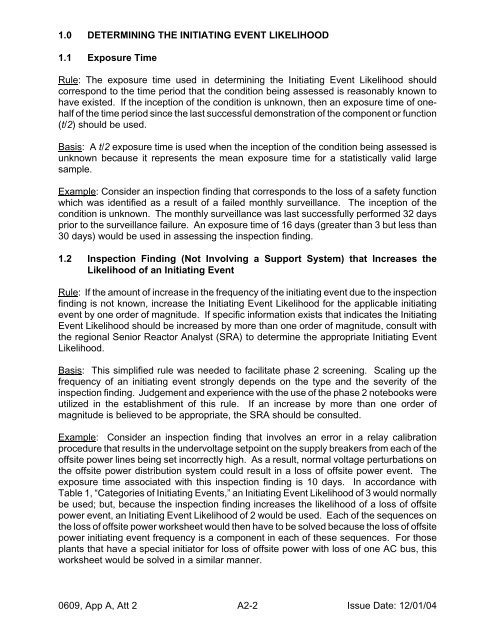IMC 0609, App A - NRC
IMC 0609, App A - NRC
IMC 0609, App A - NRC
Create successful ePaper yourself
Turn your PDF publications into a flip-book with our unique Google optimized e-Paper software.
1.0 DETERMINING THE INITIATING EVENT LIKELIHOOD<br />
1.1 Exposure Time<br />
Rule: The exposure time used in determining the Initiating Event Likelihood should<br />
correspond to the time period that the condition being assessed is reasonably known to<br />
have existed. If the inception of the condition is unknown, then an exposure time of onehalf<br />
of the time period since the last successful demonstration of the component or function<br />
(t/2) should be used.<br />
Basis: A t/2 exposure time is used when the inception of the condition being assessed is<br />
unknown because it represents the mean exposure time for a statistically valid large<br />
sample.<br />
Example: Consider an inspection finding that corresponds to the loss of a safety function<br />
which was identified as a result of a failed monthly surveillance. The inception of the<br />
condition is unknown. The monthly surveillance was last successfully performed 32 days<br />
prior to the surveillance failure. An exposure time of 16 days (greater than 3 but less than<br />
30 days) would be used in assessing the inspection finding.<br />
1.2 Inspection Finding (Not Involving a Support System) that Increases the<br />
Likelihood of an Initiating Event<br />
Rule: If the amount of increase in the frequency of the initiating event due to the inspection<br />
finding is not known, increase the Initiating Event Likelihood for the applicable initiating<br />
event by one order of magnitude. If specific information exists that indicates the Initiating<br />
Event Likelihood should be increased by more than one order of magnitude, consult with<br />
the regional Senior Reactor Analyst (SRA) to determine the appropriate Initiating Event<br />
Likelihood.<br />
Basis: This simplified rule was needed to facilitate phase 2 screening. Scaling up the<br />
frequency of an initiating event strongly depends on the type and the severity of the<br />
inspection finding. Judgement and experience with the use of the phase 2 notebooks were<br />
utilized in the establishment of this rule. If an increase by more than one order of<br />
magnitude is believed to be appropriate, the SRA should be consulted.<br />
Example: Consider an inspection finding that involves an error in a relay calibration<br />
procedure that results in the undervoltage setpoint on the supply breakers from each of the<br />
offsite power lines being set incorrectly high. As a result, normal voltage perturbations on<br />
the offsite power distribution system could result in a loss of offsite power event. The<br />
exposure time associated with this inspection finding is 10 days. In accordance with<br />
Table 1, “Categories of Initiating Events,” an Initiating Event Likelihood of 3 would normally<br />
be used; but, because the inspection finding increases the likelihood of a loss of offsite<br />
power event, an Initiating Event Likelihood of 2 would be used. Each of the sequences on<br />
the loss of offsite power worksheet would then have to be solved because the loss of offsite<br />
power initiating event frequency is a component in each of these sequences. For those<br />
plants that have a special initiator for loss of offsite power with loss of one AC bus, this<br />
worksheet would be solved in a similar manner.<br />
<strong>0609</strong>, <strong>App</strong> A, Att 2 A2-2 Issue Date: 12/01/04
















